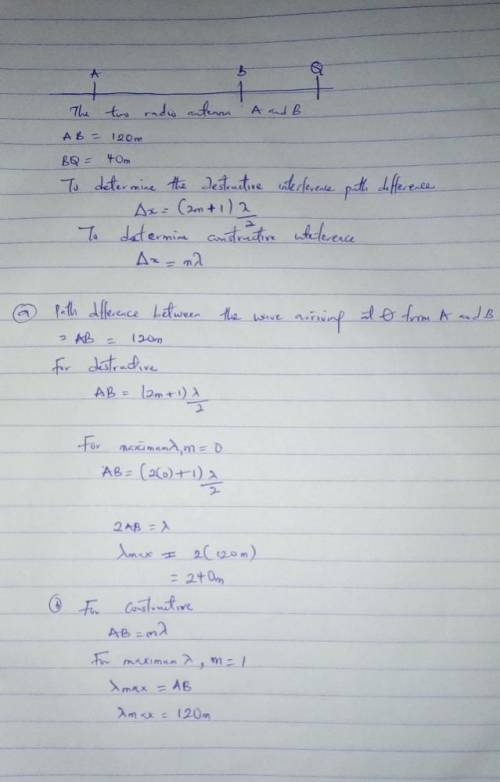
Two radio antennas A and B radiate in phase. Antenna B is 120 m to the right of antenna A. Consider point Q along the extension of the line connecting the antennas, a horizontal distance of 40 m to the right of antenna B. The frequency, and hence the wavelength, of the emitted waves can be varied.
(a) What is the longest wavelength for which there will be destructive interference at point Q?
(b) What is the longest wavelength for which there will be constructive interference at point Q?

Answers: 2


Another question on Physics

Physics, 22.06.2019 08:30
The coefficient of friction is a number that represents the resistance to sliding between two in contact with one another.
Answers: 2

Physics, 22.06.2019 12:30
Consider a system with two masses that are moving away from each other. why will the kinetic energy differ if the frame of reference is a stationary observer or one of the masses?
Answers: 1

Physics, 22.06.2019 23:00
Acommon technique in analysis of scientific data is normalization. the purpose of normalizing data is to eliminate irrelevant constants that can obscure the salient features of the data. the goal of this experiment is to test the hypothesis that the flux of light decreases as the square of the distance from the source. in this case, the absolute value of the voltage measured by the photometer is irrelevant; only the relative value conveys useful information. suppose that in part 2.2.2 of the experiment, students obtain a signal value of 162 mv at a distance of 4 cm and a value of 86 mv at a distance of 5.7 cm. normalize the students' data to the value obtained at 4 cm. (divide the signal value by 162.) then calculate the theoretically expected (normalized) value at 5.7 cm.
Answers: 2

Physics, 22.06.2019 23:20
Acharge q experiences no net force at a particular point in space. which of the following situations described below must always be true? -there are no other charges nearby. -if there are other charges nearby, they must all have the same sign as q. -if there are other charges nearby, they must all have the opposite sign of q. -if there are other charges nearby, the total positive charge must equal the total negative charge. -none of the above
Answers: 2
You know the right answer?
Two radio antennas A and B radiate in phase. Antenna B is 120 m to the right of antenna A. Consider...
Questions

Health, 13.01.2021 06:30

Arts, 13.01.2021 06:30


Mathematics, 13.01.2021 06:30



Mathematics, 13.01.2021 06:30


English, 13.01.2021 06:30

Biology, 13.01.2021 06:30





Mathematics, 13.01.2021 06:30


Mathematics, 13.01.2021 06:30

Social Studies, 13.01.2021 06:30


Mathematics, 13.01.2021 06:30




